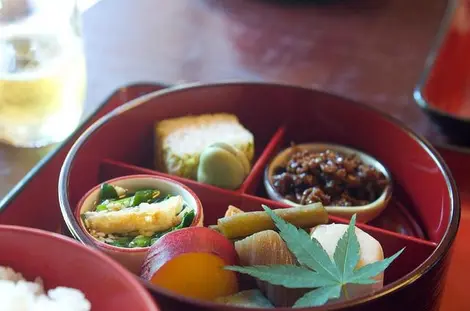Shojin ryori, the food of Buddhist monks 精進料理
At the Buddhist table
A special vegetarian, often vegan, diet is followed by monks and believers in areas influenced by Chinese Buddhism. It is called shojin ryori in Japanese, which can be translated as "food of devotion".
In Japan, shojin ryori cuisine is most prevalent in Zen temples and their surroundings, especially in Kyoto.
The precepts of Buddhism in the kitchen
It was in the thirteenth century that Chinese Zen monks arrived in Japan, first introducing shojin ryori. Explained very simply, this cuisine is based on the fundamental principle of Buddhism, which forbids them to "take life", therefore to kill any living being. This is why there is no meat or fish, but also no onions and garlic, since to consume these vegetables would be to "kill" them - as it is their bulb/roots that are eaten. Shojin ryori is therefore entirely vegetarian, often even vegan, since some do not use eggs, either.
Read : Zen
It's necessary to respect the seasons and use local products, to live in harmony with nature, and to avoid waste at all costs. In fact, some recipes make it possible to use the tops and skin of the carrots, the leaves of the radishes, and so on... usually in broths.
Buddhism prescribes an austere but nourishing diet, without alcohol or meat, combined with physical exercise to keep the body healthy, favoring spiritual work. In the West we have say the saying "a healthy mind in a healthy body", and Japanese shojin ryori surely embodies this idea perfectly!
Shojin ryori dishes
The various restrictions of the diet do not prevent Buddhist cuisine from being beautiful, or varied in ingredients and flavors. In fact, shojin ryori doesn't neglect the pleasures of the senses at all. In a temple or restaurant serving this Zen cuisine, you will often taste seasonal and/or typical vegetable tempura, such as lotus root, pumpkin or gingko seeds.
Read also: Tempura
There are also many different preparations of tofu (in sheets, cubes, fried, soup...) and another similar substance, not to be confused with tofu, which is called yuba (made from the skin formed when boiling soy milk). It is often used for decorative purposes by cutting out small flowers or leaves that garnish the dishes. A seaweed-based dashi broth and a bowl of white rice naturally accompany any meal.
The art of the table
In some temples and restaurants, especially those designed to introduce Japanese traditional cuisine, the serving of shojin ryori may seem rather similar to kaiseki. Kaiseki is a traditional Japanese gourmet meal, consisting of many small dishes and combining different cooking methods, for a complete gustatory experience.
See: Vegetarian in Japan
These two concepts combine perfectly, as shojin ryori seeks harmony with nature in the chosen ingredients, and the art of kaiseki is based on the harmony between the tastes, textures and appearance of the food. However, a kaiseki meal will not necessarily be vegetarian.
In accordance with this quest for harmony, shojin ryori dishes are served round in bowls or dishes wherever possible, and the diner is called to see a cosmic representation of the world in it...
However, in the temple lodgings where tourists can stay in Japan - in the Koyasan region for example - all these principles are not necessarily followed to the letter. The host monks often seek to make their culture more accessible to tourists.
Read more: Buddhism in Japan

























